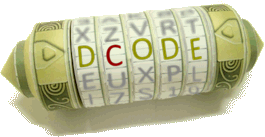Tool to compute value for Pascal's triangle, an arithmetic list of numbers where each item is either 1 or the sum of the two elements above it.
Pascal's Triangle - dCode
Tag(s) : Arithmetics, Series
dCode is free and its tools are a valuable help in games, maths, geocaching, puzzles and problems to solve every day!
A suggestion ? a feedback ? a bug ? an idea ? Write to dCode!
Pascal's Triangle
Pascal Triangle Calculator
Position of a number in Pascal Triangle
Expand a Polynomial
Calculate a Binomial Coefficient
Answers to Questions (FAQ)
What is Pascal triangle? (Definition)
Pascal's triangle is a representation in a triangular grid in which each number is the sum of the 2 numbers above it. In more mathematical terms, Pascal's triangle represents the binomial coefficients.
How to create a pascal triangle?
The principle of the Pascal triangle is based on a pyramidal/triangular construction, write 1 on the first row, and 1 1 on the second row. For the next rows, take two adjacent numbers, add their values and place this new number directly above. (The missing start and end are equal to 1).
Example: Start of the Pascal Triangle:
1
1 1
1 2 1
1 3 3 1
1 4 6 4 1
1 5 10 10 5 1
1 6 15 20 15 6 1
1 7 21 35 35 21 7 1
Values can be calculated using binomial coefficients, also used in calculation of combinations.
Pascal triangle values can be compared to the Fibonacci sequence where each number is the sum of the two preceding numbers.
Usually, mathematicians call the first row 0, same for the first column.
How to calculate a precise value in the Pascal's triangle?
A value $ V $ of the Pascal triangle at the position (row A, column B, 0-indexed) can be calculated with the binomial coefficients (and thus with factorials) and the formula $$ V = \binom{A}{B} = \frac{A!}{B!(A-B)!} $$
How to create a Pascal Triangle with Excel?
Write 1 in the cell B1, and =A2+B1 in the cell B2 and copy the contents in as many cells as you wish but do not touch column 1 and row 1. Each row (including zeros) is a new row of the Pascal triangle.
Why is the triangle named Pascal?
The triangle is named in honor of Blaise Pascal, who studied it. Although he was not the first to study it, his name is the most used, although it is also called the Khayyam or Tartaglia triangle.
Source code
dCode retains ownership of the "Pascal's Triangle" source code. Any algorithm for the "Pascal's Triangle" algorithm, applet or snippet or script (converter, solver, encryption / decryption, encoding / decoding, ciphering / deciphering, breaker, translator), or any "Pascal's Triangle" functions (calculate, convert, solve, decrypt / encrypt, decipher / cipher, decode / encode, translate) written in any informatic language (Python, Java, PHP, C#, Javascript, Matlab, etc.) or any database download or API access for "Pascal's Triangle" or any other element are not public (except explicit open source licence). Same with the download for offline use on PC, mobile, tablet, iPhone or Android app.
Reminder: dCode is an educational and teaching resource, accessible online for free and for everyone.
Cite dCode
The content of the page "Pascal's Triangle" and its results may be freely copied and reused, including for commercial purposes, provided that dCode.fr is cited as the source (Creative Commons CC-BY free distribution license).
Exporting the results is free and can be done simply by clicking on the export icons ⤓ (.csv or .txt format) or ⧉ (copy and paste).
To cite dCode.fr on another website, use the link:
In a scientific article or book, the recommended bibliographic citation is: Pascal's Triangle on dCode.fr [online website], retrieved on 2025-11-02,
- Pascal Triangle Calculator
- Position of a number in Pascal Triangle
- Expand a Polynomial
- Calculate a Binomial Coefficient
- What is Pascal triangle? (Definition)
- How to create a pascal triangle?
- How to calculate a precise value in the Pascal's triangle?
- How to create a Pascal Triangle with Excel?
- Why is the triangle named Pascal?
